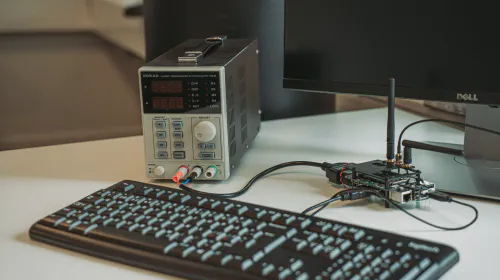Benefits and Challenges of Blockchain in Education
Salomon Kisters
Jul 27, 2022This post may contain affiliate links. If you use these links to buy something we may earn a commission. Thanks!
One of the key challenges facing educational institutions today is the need to collect, store, and analyze data on each student’s academic journey. This data consists of individual learning outcomes, student portfolios, and academic progress.
There are benefits and challenges to using blockchain in education. The ability to efficiently organize such data across different departments will help the institution improve student retention and graduation rates. On the other hand, the primary challenge is understanding how to integrate the technology into the existing educational systems.
While traditional degrees are still highly valued by businesses and employers, especially in emerging economies, eventually, blockchain could transform the existing academic organizational infrastructure into a robust, secure, and publically-accessible ecosystem.
Blockchain technology can help in many ways, including improving efficiency and security in the contemporary educational system. For now, it is still a new technology, and its benefits are only beginning to be fully appreciated.
Let’s examine the main ways blockchain can benefit higher education institutions.
What is Blockchain Application and Benefits in Education?
Bitcoin, a popular cryptocurrency, is an example of a blockchain application. A blockchain is a digital asset that can only be transferred to a third party with the owner’s permission.
Moreover, this technology can be used for many other purposes in the education system. For instance, students can develop a skill such as poetry or math genius before reaching high school. Blockchain-based educational tools can recognize these skills and reward students accordingly.
Another application for blockchain technology in education is the use of smart contracts for grading. With blockchain, educators can program entire exams into the system.
Students can then take the tests, and grades can be recorded on the distributed ledger. The entire process of grading can be done using computers, but the results are encrypted and stored in the blockchain.
Blockchain technology can improve the quality of online education. There are a lot of unaccredited online institutions, and this is where the blockchain comes in. This can help prevent fraudulent activity by recording accreditations on the blockchain.
Another blockchain application for education lies in the rewards system. By using cryptocurrency, teachers and students can receive special credit for their efforts.
For example, teachers can reward their students with special credit if they perform well on a test or have completed a homework assignment. Such an approach helps in motivating students to learn.
Furthermore, it can improve record-keeping and make learning more convenient. The possibilities are endless. The only question is whether blockchain will make education better or not.
Self-acquired data learning by students
Blockchain technology has gained much popularity in the tech sector, bringing a host of new features to the table. It secures digital data by making it traceable and immutable.
Changes and updates must be verified by a network of participants, such as a community. Blockchains can also be used to authenticate users, verify data, and track ownership. Consequently, blockchains have the potential to transform education.
The Blockchain Chamber of Commerce initiates economic and educational development by addressing the gaps in skills, talents, and learning with emerging technologies. Its motto is awareness, adoption, and advocacy, and it aims to create better educational outcomes for the masses.
Other blockchain organizations involved in promoting education include the Learning Economy Foundation, Colorado's C-Lab, and the Texas Blockchain Council. These organizations have been working to develop an open data exchange protocol that allows students to share their academic records. With the help of blockchain technology, institutions can share this data more securely.
Enhanced Efficiency and Security
Implementing blockchain in online education could enable a number of new benefits for the student, as well as for the educational institutions. It could also improve the efficiency and security of the whole education process.
In a recent paper, Thayer outlined various blockchain-powered efficiency applications, including digital credentials, intellectual property management, and streamlining diploma verification. All of these applications would save time and money for both educational institutions and employers, as well as individual learners.
Another major use of blockchain in education is student records. The number of student records is virtually infinite, and verifying academic credentials is time-consuming. Blockchain could simplify the verification process by allowing the institutions to program courses and lessons directly into the blockchain.
Students could also take the exams using computers while their scores are stored safely on the blockchain. Additionally, blockchain can improve the quality of online education. Although some unaccredited online institutions may be tempting, recording their accreditations on the blockchain provides transparency and security.
Another use of blockchain in education is in securing collaborations. The authors of open educational resources fear not being duly given credit for their work. Blockchain allows users to track changes easily because new blocks in the chain are time-stamped. Unlike other methods, authors cannot remove or edit their own data.
By ensuring that no one is copying the work of other authors, block-encapsulated open educational resources will be completely incorruptible. As long as they credit their work correctly, the blockchain will provide an ideal solution for the issue of plagiarism.
Better execution of lessons and courses
A blockchain-based system for university curricula can greatly simplify the process of storing digital syllabi. Institutions typically use hard drives to store digital syllabi but worry about security concerns.
Blockchain-based storage can be more secure but is still very expensive for some institutions. Nonetheless, blockchain is a promising solution for securing university curricula.
For educators, Blockchain-based technology may be a great way to implement smart contracts and distributed ledgers in the classroom. Blockchain-based courses and lessons can be programmed into the system, and smart contracts could check the completion of tasks and assign crypto tokens to students and teachers.
In some cases, smart contracts can also automate the payment process for teachers and students, making it possible to create an automated system for education.
Blockchain Lowers Education Expenses
The use of Blockchain technology for education can be a significant cost-saving measure. The technology facilitates record sharing, which in turn lowers educational expenses.
Blockchain also improves the efficiency of verification processes, such as transfer between states and institutions.
It can also be useful for the verification of course records, which is important when transferring students to a new school. By using blockchain technology for education, universities can verify accreditation, define teaching qualifications, and atomize services while reducing administrative expenses.
Students can benefit from digital “wallets” on blockchains that store their learning data. Professors can still provide support and help in the learning process, but they can retain full ownership of their own identity-related data.
Blockchain can also help lower the costs of education by reducing the number of paper-based transcripts. Ultimately, blockchain will help reduce educational expenses and file storage space.
Private initiatives are already exploring how blockchain can help improve the learning process. By introducing educational tokens as rewards, these initiatives aim to eliminate intermediaries and unnecessary regulations, ensuring better quality education.
While the benefits of blockchain adoption are evident in the education sector, educational institutions and instructors alike remain reluctant to adopt blockchain in mainstream education.
Here are some of the key challenges of using blockchain technology for education.
Mining is a Major Challenge
The adoption of blockchain in education has been obstructed by a lack of institutional trust, which is the main challenge of this new technology.
Unlike DDBMS (Distributed Database Management System), an immutable ledger has immutable records and enables peer verification. This prevents fraud and guarantees the integrity of credentials, as the network has no need for an intermediary.
Moreover, ledgers are relevant to education in a broader sense, allowing even small, private providers of badges and resources to compete with well-established educational institutions.
The development of distributed ledgers in education promises to be more effective than the current educational administration, empowering learners and providing them with greater ownership and control over their credentials.
However, the current limited applications of blockchain in education are restricted by identity authentication, degree certification attestation, and cryptocurrency-mediated monetary transactions. Blockchain in education has been challenged by both technical and philosophical constraints.
Lack of financial resources is a major barrier to adoption
Blockchain is becoming an increasingly popular solution for the digital problems facing today’s school systems. But a lack of financial resources is still the biggest hurdle in implementing this technology.
Its adoption in education is unlikely to be widespread until more institutions invest in their infrastructure, training, and expertise. Blockchain in education is a powerful solution to this problem, but it will not happen overnight.
Another barrier is a lack of awareness. Education institutions may not be aware of blockchain, which makes it difficult to convince them of its benefits. Educators and other stakeholders must focus on building a business case that showcases the benefits of blockchain technology.
This business case must be able to convince decision-makers that blockchain is the best solution to their problems. It should also include detailed and actionable recommendations for how to use this technology in education.
Peer-to-peer cooperation is a key goal of blockchain technology in education
The blockchain has many advantages over traditional educational systems, including its immutability. Blockchains do not require central authority and can operate on a decentralized network.
Blockchains use peer-to-peer cooperation to solve problems and are designed to foster innovation and new ways of learning. The potential for blockchain technology in education is huge, but some of its downsides are also problematic.
One major benefit is its ability to prevent fraud. Blockchains are encrypted, and every piece of information is recorded sequentially.
Additionally, each piece of information is given a time stamp, which can make it extremely difficult to forge or alter a record. Since the information in a blockchain is immutable, no third party can alter previous blocks.
Furthermore, universities and colleges are the primary granters of university degrees. That makes the state and university only third parties in the blockchain, thus, potentially isolating them from its adoption.
Conclusion
While the use of blockchain technology in education is still in its infancy, it has already paved the way for new opportunities. With its speed and security, blockchain technology will benefit students and teachers alike.
The blockchain will allow learners to verify the authenticity of their data and ensure that their information is not misinterpreted or misused.
Developing a blockchain for education will help educators create more engaging learning experiences.
The current educational technology is unappealing for many students and teachers. Blockchain technology will help educators develop more exciting teaching tools, which will enhance the online learning experiences.
Similarly, students will have more opportunities than ever to show off their skills to potential employers, and a permanent record of their qualifications will support them during times of conflict.
Even so, questions about data privacy, what constitutes learning, and the role of blockchains remain unanswered.
Consequently, the mass adoption challenge is vital to overcome if we hope to implement blockchain-in-education solutions on a wide scale.
Stay informed with the latest insights in Crypto, Blockchain, and Cyber-Security! Subscribe to our newsletter now to receive exclusive updates, expert analyses, and current developments directly to your inbox. Don't miss the opportunity to expand your knowledge and stay up-to-date.
Love what you're reading? Subscribe for top stories in Crypto, Blockchain, and Cyber-Security. Stay informed with exclusive updates.
Please note that the Content may have been generated with the Help of AI. The editorial content of OriginStamp AG does not constitute a recommendation for investment or purchase advice. In principle, an investment can also lead to a total loss. Therefore, please seek advice before making an investment decision.

5 Benefits of Blockchain in Food Supply Chains
Learn about the 5 key benefits of using blockchain technology in food supply chains, including enhanced transparency, traceability, and reduced food fraud.

Advantages and Disadvantages of Blockchain in Accounting - A Comprehensive Guide
Understand the advantages and disadvantages of blockchain technology in accounting practices. Learn how blockchains can revolutionize accounting processes.

Benefits and Challenges of Blockchain in IoT
The current centralized model of IoT deployments has many security challenges. But what are the benefits and challenges of decentralized IoT?
Protect your documents
Your gateway to unforgeable data. Imprint the authenticity of your information with our blockchain timestamp